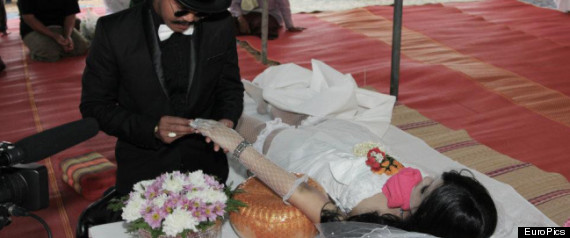Watch this high school teacher, Paul Andersen, explain how he is using technology and gaming to improve learning and engagement in his AP Biology classroom!
Articles
Atheist: Perspectives on Death – Part 5/6
This fifth post of my series summarizes the atheist’s view on death and tragedy.
For an atheist, death is final, so when Rebecca Hensler’s infant son died, remarks such as, “He is in a better place,” “God has a plan,” or “Now he’s an angel,” did not make sense for her. “Grief Without God is a Challenge for Atheists” is an article that describes how atheists are finding comfort with one another as they look for a way “to process grief and sorrow without the trappings – or support – of religious ritual and belief.”
[Read more…] about Atheist: Perspectives on Death – Part 5/6
An Old Insight on Theological Education that is Gaining Traction
I’ve been thinking and wrestling with the usefulness of theological education for a while now, and came across this older insight from one of the greatest theological thinkers out there – the late Lesslie Newbigin.
“It seems clear that ministerial training as currently conceived is still far too much training for the pastoral care of the existing congregation, and far too little oriented toward the missionary calling to claim the whole of public life for Christ and his kingdom.” – The Gospel in a Pluralist Society
He wrote this in 1989 and so many still haven’t realized this and made the necessary changes!
Book Review: The Missional Leader
 The following is an analytical book review of The Missional Leader.
The following is an analytical book review of The Missional Leader.
Roxburgh is one of the foremost leading thinkers in everything missional, yet he is a pastor at heart with over thirty years of experience in church leadership, consulting, and seminary education. He is also leads The Missional Network, which is an organization that is committed to resourcing missional leaders. On the other hand, Romanuk is an experienced psychologist with years of organizational consulting experience. He brings expertise in assessing and developing the potential of people in leadership roles.
The thesis of this book is that every church needs to move from a consumeristic model to a missional model, since the very nature of the church is to be God’s missionary people. Roxburgh and Romanuk explain how leaders need to make this transition first personally before being able to lead his/her church through this transition.
A New Form of Community?
In the 1960s, Edward T. Hall developed a theory based on the relationship between space, culture, community, and belonging. His research is becoming increasingly important for us as we discern how to better engage in community.
After all, the biblical mandate for us is to be in community, but what does that actually look like? The wineskins can change, can’t they?
- Public Space (50+ people present) – Our weekend gathering or a sporting event is what the public space looks like. You belong, you are part of a community, you somewhat get to know those around you, but there is not much of an opportunity to really get to know others.
- Social Space (20-50 people present) – This is a party-like environment where we are safe to decide who we would like to grow a deeper relationship with. It’s big enough that a newcomer won’t feel like they’re the centre of attention, yet it’s small enough that no one will fall through the cracks. It’s big enough that everyone will find someone to connect with, but it’s small enough that meaningful conversation can take place, without it being uncomfortable. You belong, you are part of a community, and it’s a safe place to take that next step.
- Personal Space (8-12 people present) – This is the typical small group environment, where you intentionally are connecting with others to go deeper, share life together, pray with one another, and allow yourself to be known. Private information is shared, but this isn’t the place where you are completely vulnerable and baring your whole soul.
- Intimate Space ( 1-3 people present) – This is an environment that you let only a few people into. It could be a spouse, a best friend, or an accountability group. This is an environment where nothing is held back and there is a lot of intentionality in sharpening one another, being accountable to one another, and being intentional in community.
In churches, we have been very intentional with the public and personal space, and sometimes with the intimate space, but not really with the social space.
Eerie: Perspectives on Death – Part 4/6
This fourth post of my series highlights a story that went viral because of it’s unorthodox ways and eeriness.
The fourth perspective on death that I am going to be exploring is the remorseful response that can be sometimes eerie when grieving a tragic death.
After Chadil’s girlfriend of ten years died in a car accident, he decided to marry his dead girlfriend, out of guilt, in a funeral/wedding ceremony in Thailand. In Pravattiyagul’s article, he comments that “the “wedding” was his attempt to right a wrong, however belated the gesture might have been.” Consequently, Chadil’s self-admission that he married her out of guilt reveals that he is journeying through the various stages of grief.
This story was not only viral in Thailand, but over 100,000 Facebook users shared it at the time Pravattiyagul wrote his article. When a story like this goes viral, individuals on the various social networking sites feel like they have the privilege to say things that they would never say to an individual grieving the death of a loved one. For example, one individual said,“Well at least he didn’t try to marry a guy,” while another said “OH NOWWW he wants to marry her…really???? That’s just gross and freaky. Wish she could just live again long enough to sit up and slap him for not marrying her after 10 years of going together.”
Religious Faith: Perspectives on Death – Part 3/6
This third post of my series highlights one of the most recent deaths that have not only impacted Western culture, but also our global culture because of her widespread fame and music – Whitney Houston’s death.
The third perspective on death that I am going to be exploring is the religious response.
Due to Whitney Houston’s widespread fame, there have been countless tweets, blogs, and news reports regarding her death and the response of individuals to her death. For example, Jessica Simpson tweeted, “I found my voice singing Whitney Houston’s music. Today I lost my idol.” Rosie O’Donnell tweeted, “Dear God … There is a grief that can’t be spoken.” And Busta Rhymes tweeted, “Can’t believe we’ve lost another 1 of our Royalty. Sister Queen Whitney Houston. God Bless on ur journey as u now stand with the Most High.”
These are artists and celebrities, who are not known for their faith convictions, but still seemed to express their grief through a lens of faith, whether it be genuine or merely language.
Due to Whitney Houston’s Christian background, her funeral, which was broadcasted live over the Internet, was probably one of the most Gospel and faith filled funerals that many non-Christians would have ever witnessed. From Newark’s Mayor Cory Booker addressing the crowd with these words, “We are here to mourn our loss, but to celebrate her life. God is in heaven, and with him is one of our angels, Whitney Houston,” to Christian songs, Scripture, and a sermon, her funeral depicts the way many in our culture are able to process tragic death through religious faith.
Join me next time as I explore another one of our culture’s perspectives on death.
Loss of Hope: Perspectives on Death – Part 2/6
In stark contrast to my first post in this six part series, this article takes the time and space to explore the emotions that individuals go through when they lose a loved one, especially when it is a tragic death that takes a young person’s life. For an introduction to my six part series, click here.
The second perspective on death that I am going to be exploring is the loss of hope.
On Feb 21, 2011, Laura Chee’s life came to an end. Click here to read about her story. When reading through this story, I’m sure you picked up on the dehumanizing/humanizing theme that underlines this story, especially when Judge Day refused to use the word accident to explain the death of 23-year-old Laura Chee. He told the court that Stephanie Gaylene Beckley, a 27-year-old mother of two, who had been free on bail, and who didn’t attend Alcoholics Anonymous meetings after her previous charges, “killed Laura” while driving with a blood alcohol level that was twice the legal limit. Judge Day called her actions “grossly selfish.” Although Beckley did kill Laura, the author tries not to dehumanize Beckley by including a few sentences on her remorse over the situation. The author’s attempt is quickly forgotten when he goes back describing the “despicable” actions of Beckley at the police station. As a result, the article ends with the author dehumanizing Beckley. In contrast, it begins with the author humanizing Laura by providing a look into the hurt that her parents, sister, and friends have experienced and will continue to experience for a very long time.
Another theme that is found in this story is the loss of a part of each family member’s identity that came with the loss of Laura. Her father told the court, “My identity was taken from me that evening.” Her mother wrote, “Nothing can mend my broken heart.” And her sister expressed how “a part of me died with her.” The pain that the family is experiencing is so deep that it has hit the core of each of their beings – they are disoriented and are, so far, without hope for the future.
Join me next time as I explore another one of our culture’s perspectives on death.
The Girl Effect
Watch this powerful video on the Girl Effect, which is the unique potential of 600 million adolescent girls to end poverty for themselves and the world.
Welcome to the Social Media Revolution
Check out this insane video on how powerful social media has become in our entire world.




